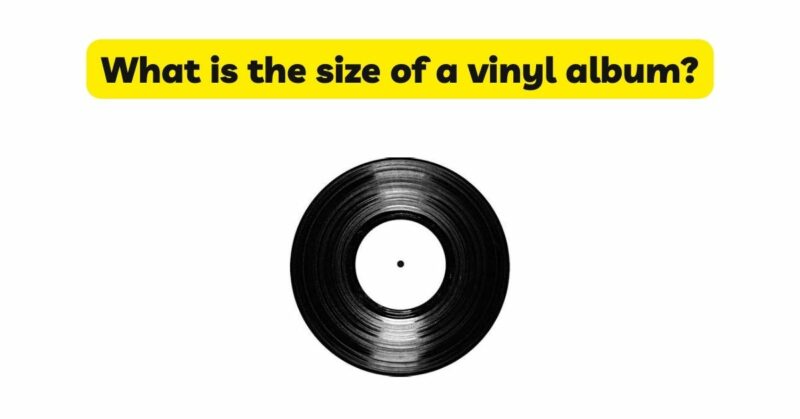Vinyl albums have made a triumphant comeback in recent years, captivating music enthusiasts with their warm analog sound and tactile experience. If you’re curious about the size of a vinyl album, this article will delve into the dimensions of these beloved musical artifacts. We will explore the standard size of vinyl albums, discuss variations and exceptions, and highlight the significance of album size in the vinyl listening experience.
- Standard Size of Vinyl Albums: The standard size of a vinyl album, commonly referred to as an LP (Long-Playing) record, adheres to industry-recognized dimensions. The most prevalent standard size for vinyl albums is as follows:
- 12-inch LP: The standard size for most vinyl albums is approximately 12.375 inches (313 mm) in height and 12.375 inches (313 mm) in width. This larger size provides ample space for album artwork, lyrics, liner notes, and other relevant information.
- Importance of Vinyl Album Size: The size of a vinyl album plays a significant role in several aspects of the vinyl listening experience. Here are a few key reasons why album size is important:
- Artistic Presentation: Vinyl albums offer a canvas for artists and designers to showcase their creativity through album artwork. The larger size of a 12-inch LP allows for more intricate and detailed visuals, enabling the artwork to be appreciated in its intended form.
- Immersive Experience: The larger album size creates a more immersive and engaging experience for the listener. Holding a 12-inch LP and examining its artwork while listening to the music enhances the connection between the listener and the artist’s vision.
- Enhanced Packaging: The larger size of vinyl albums allows for more extensive packaging options. Gatefold covers, for example, can fold open to reveal additional artwork, photographs, or supplementary content. The spaciousness of the album size provides opportunities for more elaborate and captivating packaging designs.
- Variations and Exceptions: While the standard size for vinyl albums is the 12-inch LP, there are variations and exceptions within the vinyl record industry. These variations can be influenced by factors such as regional preferences, special editions, box sets, and artistic visions. Here are a few notable variations and exceptions:
- Miniature LPs: Some vinyl releases, particularly limited editions or special releases, feature smaller-sized albums. These miniature LPs typically maintain the same aspect ratio but reduce the dimensions to create a unique collectible item.
- 10-inch LPs: Although less common than the standard 12-inch LPs, 10-inch LPs have been utilized for certain releases. These records offer a middle ground between the compactness of 7-inch singles and the larger canvas of 12-inch LPs.
- Box Sets: Box sets often contain multiple vinyl records packaged together in a larger box or slipcase. The size of the box or slipcase can vary depending on the number of records included and the design choices made by the artist or label. These variations allow for more extensive artwork and elaborate packaging.
- Picture Discs: Picture discs are vinyl records with an image or artwork embedded between two transparent vinyl layers. The size of picture disc albums adheres to the standard size dimensions, but the visual elements embedded within the record provide unique and captivating visuals.
- Design Considerations: When designing vinyl album covers and packaging, it is crucial to consider the standard size to ensure compatibility and consistency within the vinyl record industry. Artists, graphic designers, and record labels should take into account the specific dimensions and aspect ratios to optimize the visual impact of the artwork and text. This ensures that the album cover fits appropriately within the standard sleeve and provides a cohesive experience for vinyl collectors and music enthusiasts.
- Handling and Storage: Due to their larger size, vinyl albums require special care in handling and storage. It is advisable to handle albums by their edges to avoid fingerprints, smudges, or potential damage to the playing surface. Proper storage is also crucial to maintain the integrity of vinyl albums. Storing albums vertically in a controlled environment away from direct sunlight and extreme temperatures helps prevent warping and other forms of damage.
- The Vinyl Experience: The size of a vinyl album contributes to the unique and immersive experience that vinyl enthusiasts cherish. From examining the detailed artwork to carefully placing the record on the turntable, the larger album size amplifies the tactile and visual aspects of vinyl listening. It creates a sense of connection between the listener, the artist, and the music itself.
Conclusion: The standard size of a vinyl album is approximately 12.375 inches (313 mm) in height and 12.375 inches (313 mm) in width. This larger size allows for immersive album artwork, enhanced packaging options, and an engaging listening experience. While the standard 12-inch LP is most common, variations and exceptions exist, such as miniature LPs, 10-inch LPs, box sets, and picture discs. Adhering to the standard album size ensures compatibility and consistency within the vinyl record industry. By appreciating the significance of album size, handling vinyl albums with care, and storing them properly, music enthusiasts can fully immerse themselves in the timeless appeal of vinyl listening.


